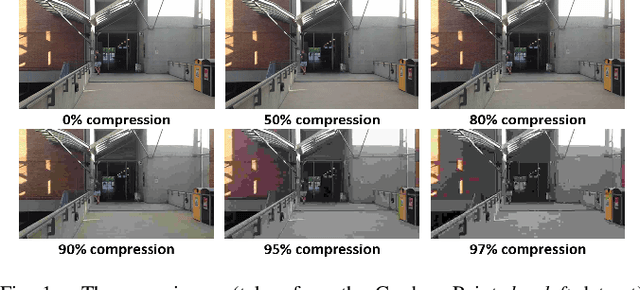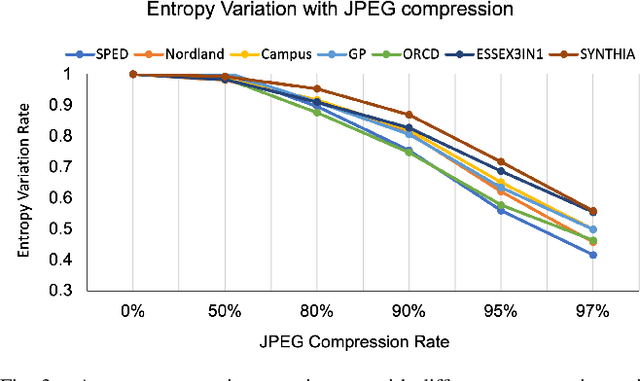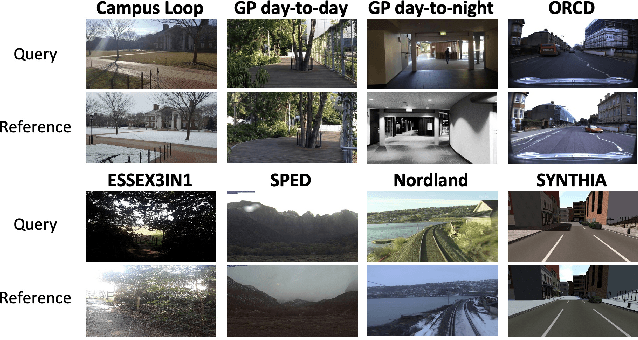Mihnea-Alexandru Tomita
Visual Place Recognition with Low-Resolution Images
May 09, 2023Abstract:Images incorporate a wealth of information from a robot's surroundings. With the widespread availability of compact cameras, visual information has become increasingly popular for addressing the localisation problem, which is then termed as Visual Place Recognition (VPR). While many applications use high-resolution cameras and high-end systems to achieve optimal place-matching performance, low-end commercial systems face limitations due to resource constraints and relatively low-resolution and low-quality cameras. In this paper, we analyse the effects of image resolution on the accuracy and robustness of well-established handcrafted VPR pipelines. Handcrafted designs have low computational demands and can adapt to flexible image resolutions, making them a suitable approach to scale to any image source and to operate under resource limitations. This paper aims to help academic researchers and companies in the hardware and software industry co-design VPR solutions and expand the use of VPR algorithms in commercial products.
Data-Efficient Sequence-Based Visual Place Recognition with Highly Compressed JPEG Images
Feb 26, 2023



Abstract:Visual Place Recognition (VPR) is a fundamental task that allows a robotic platform to successfully localise itself in the environment. For decentralised VPR applications where the visual data has to be transmitted between several agents, the communication channel may restrict the localisation process when limited bandwidth is available. JPEG is an image compression standard that can employ high compression ratios to facilitate lower data transmission for VPR applications. However, when applying high levels of JPEG compression, both the image clarity and size are drastically reduced. In this paper, we incorporate sequence-based filtering in a number of well-established, learnt and non-learnt VPR techniques to overcome the performance loss resulted from introducing high levels of JPEG compression. The sequence length that enables 100% place matching performance is reported and an analysis of the amount of data required for each VPR technique to perform the transfer on the entire spectrum of JPEG compression is provided. Moreover, the time required by each VPR technique to perform place matching is investigated, on both uniformly and non-uniformly JPEG compressed data. The results show that it is beneficial to use a highly compressed JPEG dataset with an increased sequence length, as similar levels of VPR performance are reported at a significantly reduced bandwidth. The results presented in this paper also emphasize that there is a trade-off between the amount of data transferred and the total time required to perform VPR. Our experiments also suggest that is often favourable to compress the query images to the same quality of the map, as more efficient place matching can be performed. The experiments are conducted on several VPR datasets, under mild to extreme JPEG compression.
Data Efficient Visual Place Recognition Using Extremely JPEG-Compressed Images
Sep 17, 2022



Abstract:Visual Place Recognition (VPR) is the ability of a robotic platform to correctly interpret visual stimuli from its on-board cameras in order to determine whether it is currently located in a previously visited place, despite different viewpoint, illumination and appearance changes. JPEG is a widely used image compression standard that is capable of significantly reducing the size of an image at the cost of image clarity. For applications where several robotic platforms are simultaneously deployed, the visual data gathered must be transmitted remotely between each robot. Hence, JPEG compression can be employed to drastically reduce the amount of data transmitted over a communication channel, as working with limited bandwidth for VPR can be proven to be a challenging task. However, the effects of JPEG compression on the performance of current VPR techniques have not been previously studied. For this reason, this paper presents an in-depth study of JPEG compression in VPR related scenarios. We use a selection of well-established VPR techniques on 8 datasets with various amounts of compression applied. We show that by introducing compression, the VPR performance is drastically reduced, especially in the higher spectrum of compression. To overcome the negative effects of JPEG compression on the VPR performance, we present a fine-tuned CNN which is optimized for JPEG compressed data and show that it performs more consistently with the image transformations detected in extremely compressed JPEG images.
 Add to Chrome
Add to Chrome Add to Firefox
Add to Firefox Add to Edge
Add to Edge